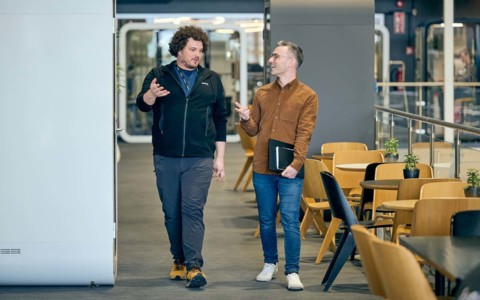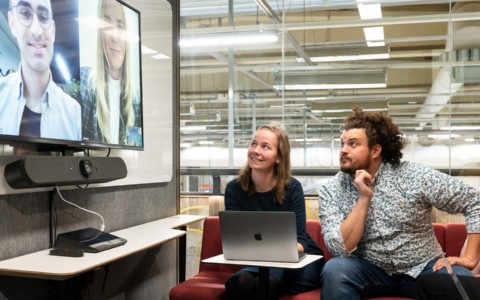Working and interacting with others from a remote location can be a challenge without the right technological tools for it. This is where the concept of telepresence comes in. Unlike just normal phone calls, the goal of telepresence technology is to create an even more authentic experience, for example by bringing lifelike sound, video, and more into remote interactions. What is best, new technologies that enable authentic face-to-face interaction even remotely are developing at a fast rate.
Telepresence: Science Fiction or Workplace Reality?
The main advantage of telepresence technology at work is that it enables workers to have realistic, lifelike interactions with others regardless of location. In other words, because of telepresence, talking to someone at a remote location feels as if they were physically in the same room.
Telepresence technology makes seamless remote communication and collaboration possible. However, remote meetings and video conferencing technology have their limitations that can break the illusion of being face-to-face with someone calling from a remote location.
That is why creating an immersive virtual experience is crucial for telepresence technology to work in practice. For remote meetings to feel authentic and lifelike, the technology used to communicate must be up to the highest standards. Just about any webcam or flimsy headset microphone will not do.
Some telepresence technologies incorporate even haptic stimuli to improve the authenticity of the experience. Nowadays, even demanding surgery operations can be conducted using remotely controlled technology. This way professionals of different areas of expertise can do their work without being present in person. However, in most cases, telepresence is used to let people see and speak to each other without being in the same room.
Lifelike presence from a remote location
Without proper technological tools, whether it is software or hardware, interacting with others from a remote location does not always live up to the real thing. The limitations of internet connections can play a role in creating an immersive experience as well. Even a slight delay can break the illusion of real face-to-face interaction.
Either way, new telepresence technologies offer many benefits that are not limited to just the office environment.
- Cost and time savings. Video meeting and teleconferencing technologies have removed the need to travel for attending every single meeting. This helps save people’s time and the costs of expensive flight tickets and other travel expenses. Therefore, telepresence solutions are better for the environment as well.
- Better work-life balance. When people do not have to be physically present to attend a meeting or converse with each other, they are free to work from wherever they want. This allows remote and hybrid work for more and more employees. With fewer people working in person, companies can save on the expenses of operating an office.
- Teamwork and productivity. Video meetings and other forms of telepresence are not only a great way to save time that would otherwise be spent traveling, but they also foster productivity and collaboration. Collaboration at work is made more convenient with screen sharing and other common features of remote meeting tools.
- More personal interaction. Real face-to-face interaction is difficult to replicate with technology. However, telepresence technologies beat simple phone calls by adding a visual element in addition to just sound. This enhances the experience of video meetings as participants can see each other and therefore pick up different nuances and facial expressions.
- Integration of other technologies. Telepresence technology is only one area where new innovations are developed at an increasing rate. Things like virtual and augmented reality can make video meetings even more immersive and authentic in the future. Virtual reality is often spoken of in the context of a so-called virtual presence where the user is transformed to another, virtual environment.
- Applications in education. Telepresence technologies have exciting opportunities in the educational context as well. Whether it is onboarding a new team member at work or attending a course across continents, physical presence is no longer a requirement for learning new skills.
Authentic face-to-face interaction for video conferencing
The degree of immersion in a video meeting is highly dependent on technology. Although even less advanced and sophisticated video conferencing tools and hardware can get the job done, they leave much to be desired.
Most importantly, video and audio quality can prevent a video call from feeling authentic and lifelike. A pixelated and choppy video connection with just the other person’s head floating on your laptop screen is far from a real face-to-face conversation. Poor audio quality, on the other hand, can distort the other person’s voice beyond recognition or make them sound like they are talking to you inside an echoing cave.
There is of course more than just video and audio that add up to the level of authenticity in a remote meeting. Unfortunately, most telepresence technologies fail at one or more aspects and are unable to create an actual lifelike experience. With its combination of advanced and analog video meeting technology, Framery Contact has replicated a realistic face-to-face meeting experience.
True to the highest standards of telepresence technology, Framery Contact makes it feel like you are face-to-face in the same room with the other person.
This is possible only with the most advanced technology used to capture video and sound, and then replicate them to the person on the other side of the screen. The participants are both visually and acoustically isolated inside the pods to remove any distractions that could break the illusion of actual face-to-face interaction.
Read more about Framery Contact and how we are revolutionizing virtual meetings.




